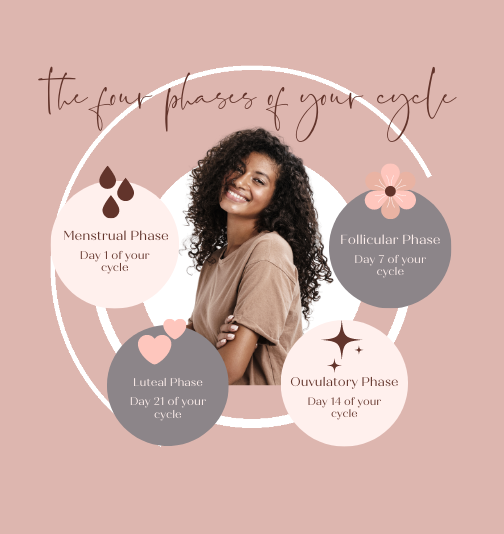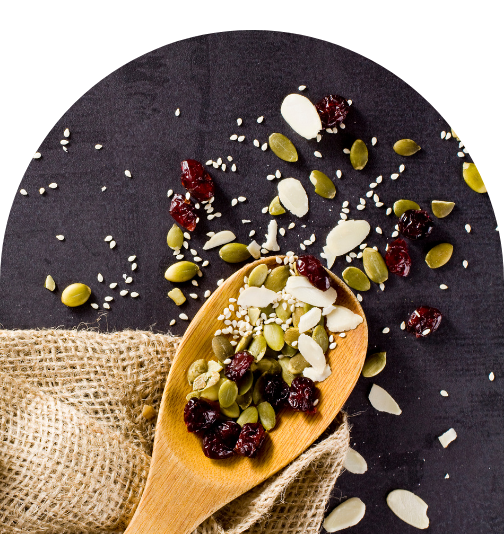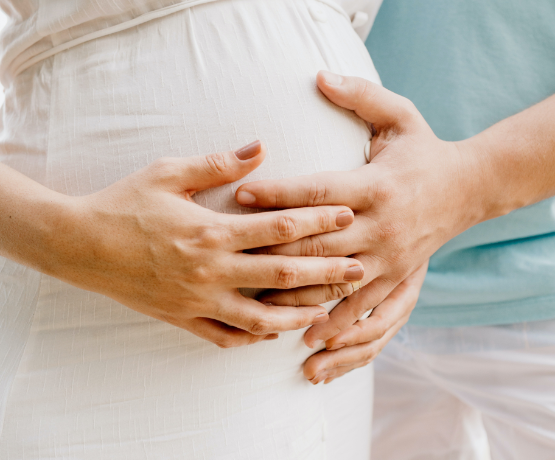A holistic approach to optimizing fertility
As many of our readers align to the values of optimizing fertility naturally, Dr. Christina and I have worked and talked with never-ending enthusiasm about how your diet and lifestyle make the foundation of the holistic fertility path. Our program has an 85% success rate in getting couples pregnant… naturally! Today’s article is about seed cycling. Seed cycling is a holistic approach to preparing the body for preconception by incorporating specific seeds into the diet. This practice is based on the idea that certain seeds contain essential nutrients and phytochemicals that can help regulate hormonal balance and support reproductive health in both men and women.
Seed cycling involves consuming specific seeds during different phases of the menstrual cycle (or lunar cycle). It aims to harness the natural hormonal fluctuations in the body and provide the necessary nutrients to support each phase effectively.
Phases of Seed Cycling
The seed cycling process is divided into two phases, the follicular phase and the luteal phase, which correspond to different stages of the menstrual cycle. Menstrual and ovulatory phases can sometimes be counted as their own phase because they mark significant stages in the menstrual cycle; however, they technically fall under the follicular and luteal phases.

If you’re trying to get pregnant and you struggle with PCOS, click here to watch our free, on-demand masterclass and discover the proprietary 4R Fertility Formula (TM) we use to help you get pregnant naturally or get better results with IVF and IUI.
Follicular Phase
The follicular phase begins on the first day of menstruation and lasts until ovulation. During this phase, the focus is on supporting estrogen production. To achieve this, we recommend consuming a blend of flaxseeds and pumpkin seeds daily. These seeds are rich in lignans and omega-3 fatty acids, which help balance estrogen levels and support healthy follicle development.
Luteal Phase
The luteal phase starts after ovulation and lasts until the onset of the next menstrual cycle. This phase requires support for progesterone production. To do this, we recommend incorporating sesame seeds and sunflower seeds into your daily diet. These seeds are packed with vitamin E and essential fatty acids, which aid in progesterone synthesis and promote a healthy uterine lining.
Benefits of Seed Cycling for Fertility
- Hormonal Balance: The unique combination of seeds used in seed cycling provides essential nutrients that can help balance hormone levels, potentially improving fertility outcomes.
- Nutrient-Rich: Seeds are a powerhouse of vital nutrients, including vitamins, minerals, and essential fatty acids, that support overall reproductive health.
- Anti-inflammatory Effects: Many seeds used in seed cycling have anti-inflammatory properties, which may help reduce inflammation in the reproductive system and promote a healthier environment for conception.
- Gentle and Natural: Seed cycling is a gentle and natural approach that can be easily incorporated into a daily routine. It complements conventional fertility treatments and can be used as part of a comprehensive fertility optimization program.
Should Men Consider Seed Cycling?
Absolutely! While seed cycling is often associated with supporting women’s hormonal health and fertility, it can also benefit men. The seeds used in seed cycling are rich in essential nutrients and phytochemicals that can help balance hormone levels and support overall reproductive health in both sexes.
For men, seed cycling can be a valuable addition to their wellness routine, particularly if they are looking to optimize their fertility. The seeds used in the process contain important nutrients such as zinc, vitamin E, omega-3 fatty acids, and lignans, which have been linked to improved sperm quality and hormone balance.
Specifically, pumpkin seeds and sesame seeds, which are part of the seed cycling protocol, are excellent sources of zinc—a mineral crucial for male reproductive health. Zinc plays a vital role in sperm production, motility, and overall fertility.
Incorporating seed cycling into their diet can provide men with a convenient and natural way to support their reproductive system. Men can consume a blend of pumpkin seeds and sesame seeds during the respective phases of the seed cycling protocol. These seeds can be added to meals, salads, smoothies, or enjoyed as a snack.
Should women continue seed cycling while pregnant?
Seed cycling is generally not recommended during pregnancy. Pregnancy is a unique phase in a woman’s life where the hormonal balance undergoes significant changes to support the growth and development of the fetus. During pregnancy, it is essential to prioritize a well-balanced diet that meets the specific nutritional needs of both the mother and the growing baby.
Seed cycling involves consuming specific seeds during different phases of the menstrual cycle to support hormonal balance. However, during pregnancy, the hormonal fluctuations are different, and the focus shifts to providing adequate nutrients for fetal development and maternal well-being.
While seeds are generally nutritious, it is advisable for pregnant women to seek personalized advice from their healthcare provider regarding appropriate dietary choices and practices during this special time.
How to Incorporate Seed Cycling into Your Routine
- Purchase high-quality, organic seeds from a trusted source. We’ve partnered with Beeya Wellness who are widely recognized for their high quality seeds, designed specifically for women using a seed cycling regimen.
- Grind the seeds to maximize nutrient absorption. Store them in an airtight container in the refrigerator.
- During the follicular phase, add one tablespoon each of ground flaxseeds and pumpkin seeds to your daily meals or smoothies. We’ve included some simple recipe ideas below.
- In the luteal phase, consume one tablespoon each of ground sesame seeds and sunflower seeds daily.
- Stay consistent and track your cycle to adjust seed intake accordingly.
Recipe Ideas for Seed Cycling
Incorporating seeds into your daily diet is a wonderful way to enhance nutritional intake and reap their health benefits. Here are some ideas on how you can include seeds in your meals and recipes:
- Smoothies: Add a tablespoon of ground flaxseeds, chia seeds, or hemp seeds to your favorite smoothie recipes. They will blend seamlessly and provide a boost of fiber, omega-3 fatty acids, and other essential nutrients.
- Yogurt or Oatmeal Toppings: Sprinkle a mixture of seeds such as pumpkin seeds, sunflower seeds, and sesame seeds onto your yogurt or oatmeal. This adds texture, flavor, and a nutrient-packed punch to your morning meal.
- Salads: Toss a handful of seeds, such as pumpkin seeds or flaxseeds, into your salads for added crunch and nutritional value. You can also make a homemade seed mix to keep on hand and sprinkle it over various salads.
- Baked Goods: Incorporate seeds into your baking recipes. For example, you can add chia seeds or flaxseeds to muffins, bread, or homemade granola bars for extra texture and nutrition.
- Energy Balls: When making homemade energy balls or protein bars, include a combination of seeds like chia seeds, sunflower seeds, and hemp seeds. These tiny powerhouses will boost the nutrient content of your snacks.
- Stir–Fries and Sauteed Veggies: Sprinkle a handful of sesame seeds over stir-fried vegetables or sautéed greens. The seeds will add a delightful nutty flavor and provide additional nutrients.
- Homemade Trail Mix: Create your own customized trail mix by combining a variety of seeds, nuts, and dried fruits. It makes for a convenient and nutritious snack option.
- Homemade Seed Butter: Experiment with making your own seed butter. You can create delicious spreads using sesame seeds, sunflower seeds, or pumpkin seeds. Enjoy it on toast or as a dip for fruits and veggies.
Final Thoughts
While seed cycling is a promising holistic approach to optimizing fertility, it’s essential to remember that it should be used as part of a comprehensive fertility program, like the one we offer at Reimagined Fertility. Dr. Christina and I are functional medicine MDs who specialize in fertility. We’d love to help you on your journey to build the family of your dreams! Check out our free, on-demand masterclass and discover the proprietary 4R Fertility FormulaTM that we use to help couples get pregnant naturally (even after failed IVF or IUI!). Seed cycling is just one piece of the puzzle, but it can play a significant role in supporting fertility and overall reproductive health.
Remember, optimizing fertility is a journey, and with the right guidance and approach, you can increase your chances of achieving your dream of starting a family. Wishing you health, happiness, and success on your fertility journey!








